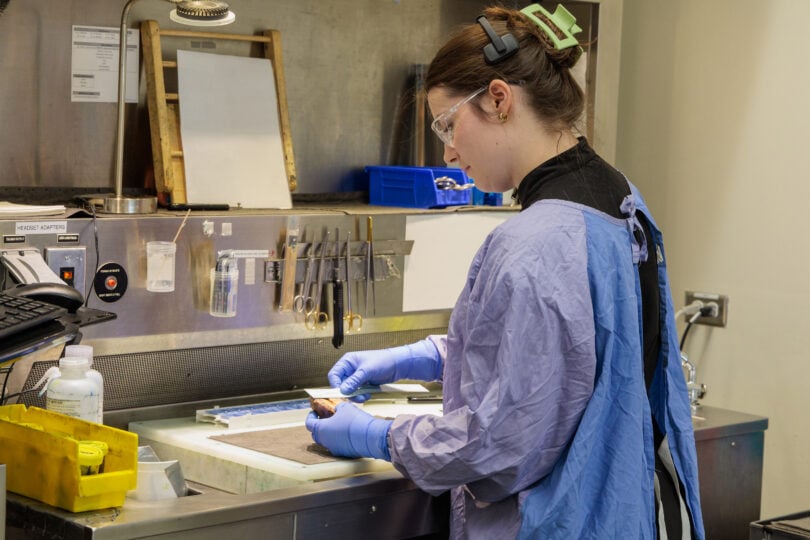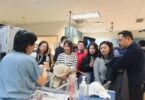April 14 is Pathologists’ Assistants Day and April 13–19 is National Medical Laboratory Week. To celebrate, let’s take a peek behind the curtain of the Anatomic Pathology Lab at St. Paul’s Hospital.
At the height of the COVID-19 pandemic, scheduled surgeries were postponed in British Columbia to prepare for a potential surge of COVID-19 patients.
“An unintended consequence of these postponed surgeries was the delay in critical cancer care,” explains Bobby Grewal, Team Lead, Anatomical Pathology at Providence Health Care (PHC). “This meant delays not only for surgeries but also for the essential laboratory work, such as grossing of these specimens for diagnosing conditions like cancer.”
Grossing, or gross examination, is the macroscopic examination of surgically removed tissue, describing the size, shape, colour and consistency. This unique skill is what underpins all diagnoses based on tissue samples.
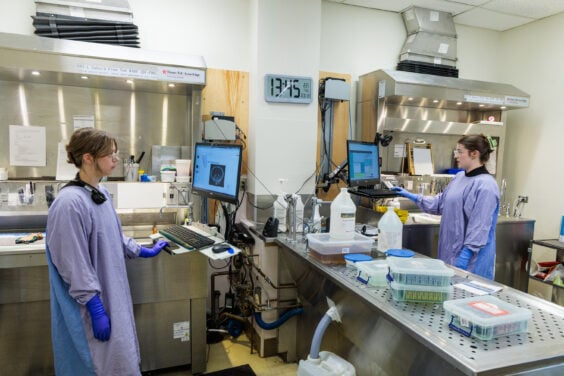
“With the push to clear the surgical backlog, our lab had to adapt quickly to meet the challenge or risk being overwhelmed by the increased volume and complexity,” Bobby continues. “Innovation became essential to meeting demand while maintaining our high patient care and quality standards.”
A story of people: Pathologists’ Assistants at PHC
When asked about the innovation that hums vibrantly throughout the PHC lab, Bobby always references the human element of the work.
“Our history has always been on developing our team members,” he says. “We believe in mentoring talented individuals, empowering them, and supporting their growth – this approach naturally drives innovation and excellence.”
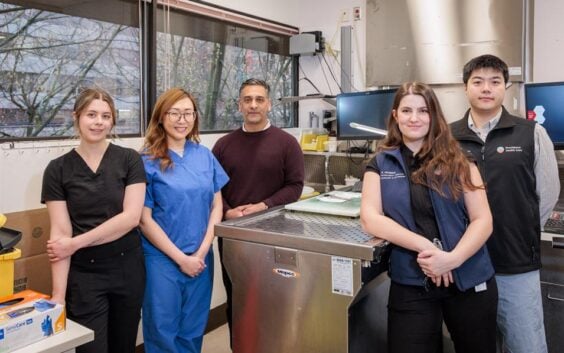
This turned out to very much be the case in the decision to bring certified Pathologists’ Assistants (PAs) into the staffing complement in the PHC lab.
Recognizing the value and skill of trained professionals, PHC focused on enhancing and expanding the skills of their team members to address the increased volumes of post-pandemic workloads.
“We soon realized that our people could be our solution,” says Bobby.
In 2019, the lab decided to only hire certified, Master’s level-trained PAs to perform gross examination. Thanks to buy-in within the lab and support from PHC’s senior leadership, and new investments into the system to support patient care, the pathology team were able to start to hire on and build out a team of certified PAs to complement the already exceptional work happening in the lab.
Welcoming PAs to PHC
“In about 85 per cent of cases, we are now delivering results in 2.5 days, which has been holding steady since the pandemic,” says Bobby. “The most critical part of our ability in being able to hold this turnaround time has been the introduction of the certified Pathologists’ Assistants to our team.”
PAs have allowed the lab to improve clinical excellence and sustain volume increases.
Crystal Leung, Pathologists’ Assistant Supervisor and Clinical Instructor with the UBC Department of Pathology & Laboratory Medicine, was hired in August 2024, after a remarkable career as a PA throughout the U.S.
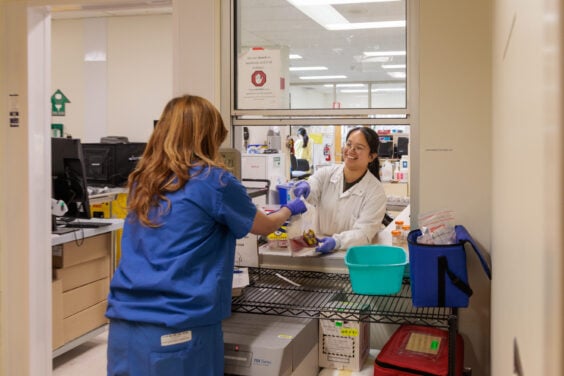
“It’s actually been a full-circle moment for me,” reflects Crystal, who started working at the Centre for Heart Lung Innovation (HLI), in 2007. “I started working as a research technician in the Cardiovascular Biobank at HLI. By working closely with the pathologists there, I learned to dissect human hearts, and I fell in love with the hands-on work of tissue dissection.”
Suggested to her by a mentor, Crystal took a leap of faith 15 years ago. She applied to and was accepted to the certified PA program at Duke University in the US, which is where the first formal training program for PAs in North America was established in 1969.
PHC currently has a team of four certified PAs on-staff in the Anatomic Pathology lab: Richard Li, Helena Froberg, Kaelyn Wagland, and Crystal Leung, who work between St. Paul’s Hospital and Mount Saint Joseph Hospital.
“We are a small but mighty team,” laughs Crystal. “We take on clinical work, while also training and educating future pathologists – PHC is really a leader in this sense.”
It takes a village: Pathologists, Pathologists’ Assistants, and Technologists
In PHC’s Anatomic Pathology lab, there are three primary roles: a pathologist, a pathologists’ assistant, and a medical laboratory technologist. While all three are very connected, each role has a very specific purpose and training.
A pathologist is a physician specializing in diagnosing diseases by microscopically examining tissues, fluids, and cells. A pathologists’ assistant (PA) supports pathologists in various tasks including macroscopic examination of patient tissues and autopsy procedures. A medical laboratory technologist performs routine laboratory tasks and operates equipment necessary for processing patient tissues.
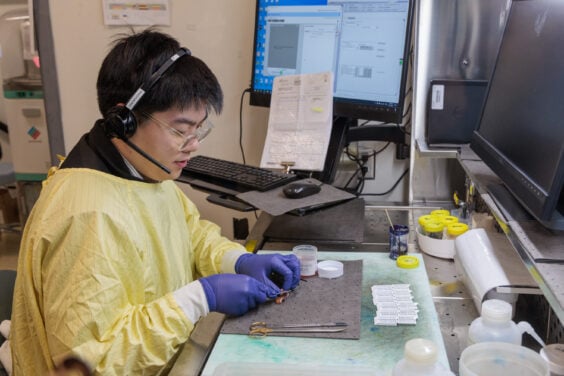
“I like to think that a PA fits between the surgery and the microscope,” summarizes Crystal. “PAs perform all dissections; we see the tissue, select appropriate sections, and prepare those tissue sections for diagnosis. The tissue then moves on to the technologists, who produce the glass slides for the pathologists to examine under the microscope.”
In the example of removing a tumor from a patient, Crystal explains that it is important for the PA to accurately describe the pertinent macroscopic characteristics of the specimen. The accurate description and tissue selection by the PA allows the pathologist to diagnose and determine the severity of the tumour. This information will ultimately guide the cancer care specialists to the most appropriate treatment options, as well as to estimate the outlook for the patient.
“The technologists, PAs, residents and pathologists all work so closely. Having those relationships and understanding of one another’s roles is invaluable,” says Crystal.
A day in the life of a PA
“Every day is exciting and different because we don’t know what we will see on the bench,” says Crystal. “While we may see the same type of organ or specimen everyday, each one is unique. This is one of the reasons why I still wake up everyday excited to go to work after being a PA for over a decade.” Crystal continues, “It is also very important to me to mentor our future generations of PAs.”
“Ultimately, we want to help patients,” explains Richard, Helena, and Kaelyn, when asked why they want to become a PA. “We are passionate about improving and advocating for patient care behind the scenes, often in ways that go unseen but are deeply meaningful to us on a personal level.”
Specimens from operating rooms and clinics get dropped off at the lab in the “accessioning” area. This is where they get a lab label and lab number and are put in the queue for grossing. Specimens range in size: from a tiny skin biopsy to an entire organ or amputated limb.
The PAs and technologists receive approximately 40,000 cases per year (in 2024, they handled 41,352 cases). That works out to about 5 to 6 complex cases per day for each PA, plus a number of simpler, more routine cases.
“The second-most important responsibility for all PAs in a teaching hospital like SPH is training the pathology residents how to perform dissections,” says Crystal. “So typically while one of us is grossing, the other is in a 1:1 teaching scenario.”
Where Pathologists’ Assistants shine
Insights and info provided by Helena Froberg.
Cancer care
- St. Paul’s Hospital works in tandem with the Providence Breast Centre at MSJ to provide leading breast cancer care for the province of BC. There, PAs are continuously enhancing protocols within the Breast Centre to ultimately enhance patient care.
- St. Paul’s Hospital is also a Centre of Excellence in Colorectal Surgery with a specific focus on colorectal cancer, inflammatory bowel disease, and other gastrointestinal diseases. PAs are the professionals behind the scenes who directly handle these types of surgical specimens, carefully examining and evaluating each component.
- The Pathologists’ Assistant writes a report, understanding what information the doctor will be looking for and anticipating their needs, based on certain criteria such as national cancer staging protocols and questions raised by the clinical care team. Certain findings by the Pathologists’ Assistant directly impact patient care. For example, PAs regularly evaluate multiple lymph nodes from cancer patients, and finding even one lymph node that is positive for tumor will change the patient’s course of treatment and outlook.
Tech innovation / AI
- There is always a push for further innovation and new technologies in the pathology laboratory. PAs are involved in the implementation of digital pathology, from digitizing microscopy slides to 3D scanning of entire surgical specimens for clinical, research, and teaching purposes. Pathologists’ Assistants are also at the forefront of up-and-coming technologies. One of our PAs, Richard Li, is working on a project that incorporates AI learning models to standard operating procedures and best grossing practices. Pathologists’ Assistants at SPH participate in the development of new technology and novel instruments from outside companies, providing valuable insight into the inner workings of specimen handling.
“We are also responsible for off-the-bench projects, too,” says Crystal. “For example, through the Innovarium Launchpad Grant, one of our PAs, Kaelyn Wagland, is leading a project involving a 3-D scanner. Being able to have access to seed-funding through the LaunchPad allows us to expand the PA role. AI and digital technology are really allowing us to extend the PA role beyond the bench.”

Looking ahead
“We have the new hospital in front of us; those are the goal posts we are aiming for,” says Bobby, explaining that his team is already operating at a heightened level of excellence and is eager to take full advantage of the new state-of-the-art facility. “I have full faith that the team is already way ahead. We have experienced the success here at PHC, and now this learning is being shared around the province, as well.”

